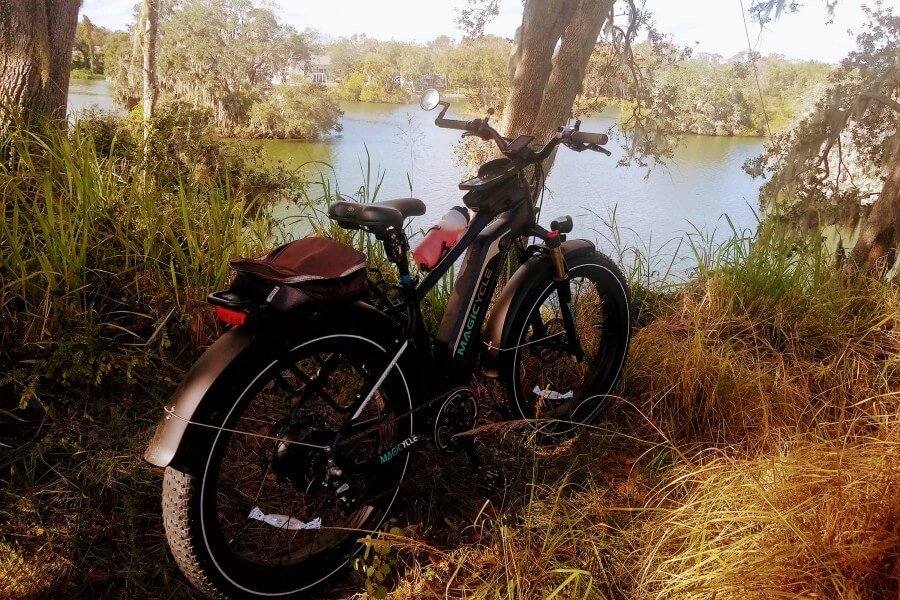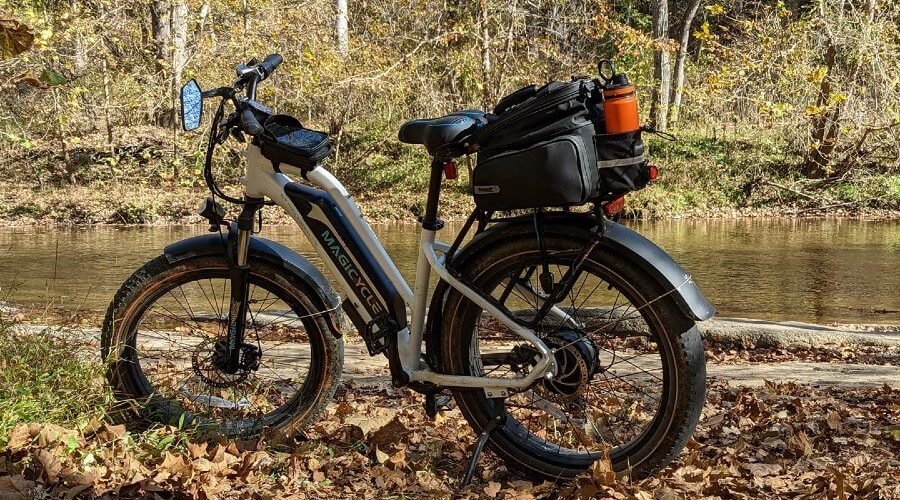Table of Contents
Tips for Finding a Great EMTB
Electric mountain bikes, or EMTBs, are rapidly growing in popularity. Indeed, the entire e-bike industry is setting records for annual sales. The EMTB segment of this mushrooming market is expected to reach 10 billion dollars within the current decade. Several years ago it was true that EMTB shoppers had very few choices, but that is no longer the case. The number of brands selling electric mountain bikes has more than kept pace with the growing popularity of EMTBs. Today the shopper has many choices, and it’s important to give careful consideration so that you make a wise choice.
EMTBs Come in Several Flavors
An important aspect of deciding on an e-bike is knowing what is available. Electric mountain bikes are definitely not “one size fits all.”

Classification
E-bikes in general, including EMTBs, fall into a specific “class” of e-bike. In most of the US, various types of e-bikes fall into three “groups” or “classes.” US states have made these classifications official regulations or laws. By dividing electric bikes for adults according to class, it becomes much easier to designate which e-bikes are suitable or legal to ride in certain areas. For example, a particular mountain trail may be safe for low-powered no throttle e-bikes, but very risky for a high-powered and much faster e-bike.
In Europe, it’s very simple. Any e-bike with a motor of 250 watts or less and a top speed of 25 km/h (15.5 mph) is essentially unregulated and can be ridden as though it were a conventional bicycle. Of course, regulations can vary from country to country. Some locations in Europe now allow up to 500 watts without regulation. In the US, it is not nearly as simple. There are 4 classes of battery-powered bikes.
Class 1
The key characteristic of Class 1 e-bikes is simply that you cannot ride without pedaling. In other words, a throttle is not allowed in Class 1. This means pedal assist only, and additionally, the top speed is limited to 20 mph. The size of the motor on Class 1 e-bikes is limited to no more than 750 watts.
For the most part, Class 1 e-bikes are required to abide by the same rules and regulations as ordinary unpowered bicycles. If you want a ride that can exceed 20 mph, then stepping up to Class 2 is necessary. The same is true if you want an e-bike with throttle capability.
Class 2
For Class 2 e-bikes, a throttle is allowed. The same pedal-assist feature found on Class 1 e-bikes are still allowed for Class 2, but not required. As with Class 1, the top allowed speed remains at 20 mph. To reach that top speed, you have the option of pedaling or not pedaling. In fact, the rider is free to use any combination of pedal assist, throttle, and pedaling.
Because this class includes the option of throttle-only riding, Class 2 e-bikes are available with 3 types of throttles…twist, trigger, or button. However, the motor power is still limited to 750 watts or less, just like Class 1. Thus, like Class 1, in most places, the rules and regulations for Class 2 are the same as for conventional bicycles.
Class 3
Due to various state regulations, Class 3 is somewhat more difficult to define. In general, however, most states have quite similar rules. The key characteristic for Class 3 is the liberty to have a higher top speed, 28 mph. At first glance, that may not seem so vastly different from the 20 mph Class 1 limit. When you are on the bike and traveling 8 mph faster, you quickly realize the difference is substantial.
As is the case with Class 1 and Class 2, motor power is limited to no more than 750 watts for Class 3 e-bikes. The big difference is that those 750 watts are capable of easily exceeding 20 mph, and with a Class 3 e-bike, you can do so…up to 28 mph. In an effort to endure that riders remain aware of their speed, Class 3 requires the e-bike to be equipped with a speedometer. Many Class 1 and 2 e-bikes are also equipped with a speedometer, but it is not required.
Class 3 also allows the use of a throttle. The singular exception is California, where even a Class 3 e-bike cannot be equipped with a throttle. Also, a few other states allow throttle usage only up to 20 mph. For faster speeds, the rider must use only pedal assist. Most states do not have limits on throttle use.
Be aware that for Class 3, some states also have a minimum age requirement. For some of these states, it is age 14, but others have a higher age required. Also, in some areas, the use of Class 3 e-bikes may be restricted on certain off-road paths or trails. Be sure to check your local regulations.
Class 4
This class is for e-bikes that are similar to mopeds in power and speed but are equipped with pedals. In most areas, Class 4 e-bikes are NOT PERMITTED on streets, roads, highways, etc. This means they are for off-road use only.
Class 4 e-bikes are freed from the power and speed restrictions that are found in classes 1-3. Thus, motor power is allowed to exceed 750 watts and go beyond 28 mph. The downside of this liberty is that they are more dangerous to ride and so more heavily regulated in most states. This usually includes licensing, registration, and carrying an insurance policy.
EMTBs — Which Type is for You?
As you go through the process of selecting an electric mountain bike, carefully think about what type of riding you are most likely to experience. Of course, most of us do not limit ourselves to one particular type or style of riding. But we probably do spend the majority of our riding time enjoying one type of riding that best suits us or is the most easily available.

DOWNHILL
Believe it or not, EMTBs are available that are designed specifically for downhill riding. In some cases, riders get to the top of a hill via a ski lift ride and then return to the bottom on their downhill electric mountain bike. This type of bike is generally designed with a long wheelbase, which gives extra stability to the ride. You may also notice specially designed handlebars and suspensions that are tuned for this type of tiding.
Trail
As with most types of ebikes for sale, the Trail EMTB is available with various suspension options. However, this can be thought of as an all-purpose type of EMTB. It is especially well-suited for beginning Electric Mountain Bike riders, and for those who want to enjoy a variety of terrains. It will not be the very best at any one type of riding, but it will allow you to enjoy many types of riding and do it well.
ENDURO
The Enduro electric mountain bikes are built tough! They have design features that let EMTB riders take on truly challenging trails. The bike is often a bit heavier and sturdier, allowing it to handle rough terrain, even at relatively high speeds. Similarly to the Trail EMTBs, the Enduros can also be used for multiple purposes.
Your Most Critical Decision for EMTBs
For many riders of electric mountain bikes, the first question they want to ask is “How far can I go on one full battery charge?” That is a good question, but it’s not the primary question.
Your first question should be in regard to the quality of the EMTB frame, suspension, and other components. What kind of reputation has been generated by the manufacturer? Does the brand own the factory that manufactures this EMTB? The quality of any EMTB should be your first consideration because it directly affects your safety. You might be surprised at the number of e-bike brands that do not own a factory, which makes excellent quality control almost impossible.
Magicycle, for example, has been building e-bikes for 16 years and they own the factory. This puts the brand in control of quality all the way from design to manufacturing to shipping. Magicycle is releasing a new full-suspension electric mountain bike in 2023. This is one worth taking a look at because Magicycle has a great reputation for building quality e-bikes at very competitive prices. In fact, no competing brands (in the same price range) have matched Magicycle’s power and quality. It is best to do your homework and know all the details about the brand. Certainly, it is best to stay away from any brand that does not own a factory.
Other EMTB Considerations
Again, the range is important to most riders, but never forget it is not as important as the overall quality of the EMTB. Of course, you will want to know something about the typical range provided by the motor and battery selected for the bike. Remember that the actual range experience is normally different for every rider. Factors such as terrain, rider weight, pedaling habits, and wind conditions play an important role in range.
Another decision to make involves suspension. You can choose between a hardtail and softail models. Hardtail models will probably have decent front suspension, but absolutely none in the rear. You could opt for a suspension seat post, but that’s not the best solution for an electric mountain bike. Most riders will definitely prefer a full-suspension EMTB, also referred to as a softail design. Your spine will appreciate the extra “cushioning” while you spend hours negotiating those bump trails!
Look, Learn, and Love
Chances are…you’ll love exploring on an EMTB. Look at all the info you can find, learn which brands are worth considering, and then enjoy the love of electric mountain biking. There is something very special about riding through uninhabited beauty far from the odor of exhaust fumes and the noise of civilization.





